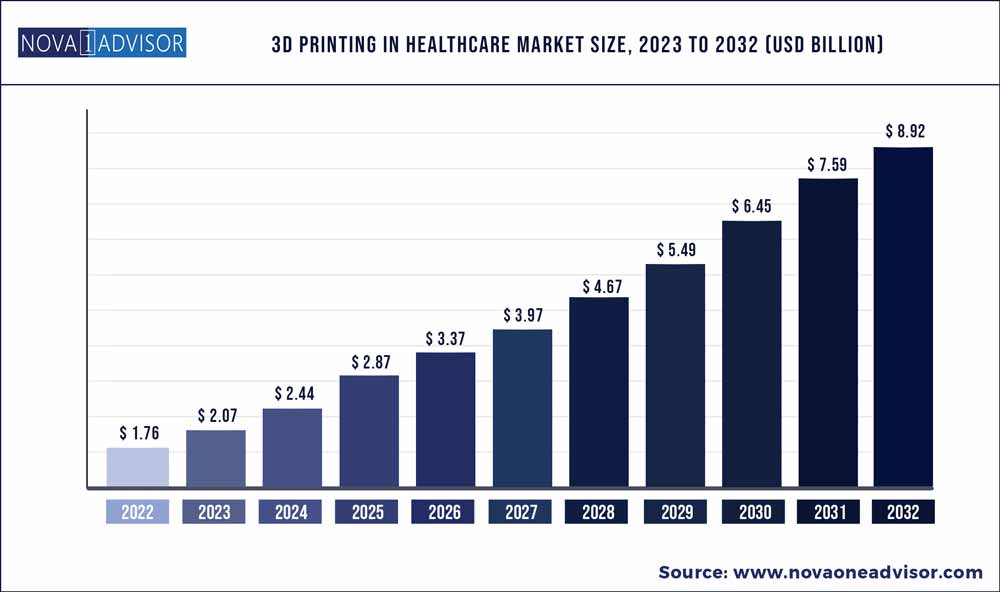The global 3D printing in healthcare market size was exhibited at USD 1.76 billion in 2022 and is projected to hit around USD 8.92 billion by 2032, growing at a CAGR of 17.61% during the forecast period 2023 to 2032.

Key Pointers:
3D printing in healthcare Market Report Scope
| Report Coverage | Details |
| Market Size in 2023 | USD 2.07 Billion |
| Market Size by 2032 | USD 8.92 Billion |
| Growth Rate from 2023 to 2032 | CAGR of 17.61% |
| Base Year | 2022 |
| Forecast Period | 2023 to 2032 |
| Segments Covered | Component, Technology, Application, End User and Geography |
| Regions Covered | North America, Europe, Asia-Pacific, Latin America and Middle East & Africa |
3D printing is a process of making dimensional solid objects in healthcare industries it is also known as additive manufacturing. The creation of a 3D printed object is achieved using additive processes. In an additive process an object is created by laying down successive layers of material until the object is created. Each of these layers can be seen as a thinly sliced cross-section of the object. It is used to produce customized medical equipment and products in healthcare sectors. In addition, 3D printing technology caters to the rise in demand for personalized medical care by providing customized medical devices based on individual needs. Furthermore, it provides several advantages over traditional reconstructive surgeries by reducing the operative risks involved during complex procedures, minimizes the susceptibility to infections, and decreases the duration of anesthesia exposure.
Moreover, technological advancements in 3D printing, customization & personalization, augmented R&D investments, presence of large patient pool, and increase in biomedical applications are the major factors driving the market growth. In addition, high cost associated with 3D printing, increase in reimbursement challenges, upsurge in copyright & patent concerns, and lack of skilled labor hamper the growth of the 3D printing in healthcare market. Rise in pharmaceutical applications and availability of bioprinting tissues & organs are opportunistic for the market growth during the forecast period. In addition, heavy investments for R&D activities, rapid expansion of customer base, increase in scope of biomedical applications, and extensive R&D activities for the advancement in 3D printers at the academic and industrial level have fueled the market growth. Furthermore, collaborations between academic institutions, hospitals, and companies have supplemented the growth of the market.
Coronavirus (COVID-19) was recognized in late December in Hubei province of Wuhan city in China. This highly contagious disease, caused by severe acute respiratory syndrome coronavirus 2 (SARS-CoV-2), is transmitted from humans to humans. The COVID-19 pandemic has resulted in nationwide lockdowns, thereby impacting every industry vertical. According to the report of the United Nations Human Rights, the COVID-19 pandemic has threatened all the members of the society. As a result, health care systems are affected, and the effective delivery of medical care and treatment to all patients has become a challenge worldwide. The COVID-19 pandemic is an unprecedented global public health challenge, during the pandemic, global healthcare systems faced many difficult challenges due to severe shortages of hospital beds and medical equipment, patient suffering from COVID-19 having acute respiratory distress syndrome (ARDS) and these patients requires high-level respiratory support to survive. Due to the shortage in equipment, the demand for 3D printing in healthcare market has increased drastically during pandemic. Moreover, the impact of COVID-19 on 3D healthcare was negative during pandemic. The most significant difficulty is the lack of equipment for the COVID-19 battle due to pandemic and the negative impact on the 3D printing in healthcare market, manufacturers are unable to manufacture and supply medical products due to lockdown. Lately, there is not sufficient personal protective equipment (PPE) for hospital workers on the front lines in this terrifying time. All around the world, hospitals are overwhelmed by the volume of patients and the lack of personal protective equipment including face masks, gloves, eye protection and clothing.
North America is expected to maintain its dominance during the forecast period due to the three major countries of North America considered in the report include the U.S., Canada, and Mexico. North America is dominating the market of overall 3D printing in healthcare and expected to dominate throughout the forecast period. This is attributed to widespread adoption of 3D printing technology and numerous collaborations between academic and commercial organizations in this region. In addition, technological innovations pertaining to 3D printing, increase in funding for advancement in 3D printers for healthcare, and upsurge in patient pool in this region has contributed to its dominance. Increase in acquisition, product launch, and product approval by key players of this market operate in North America turn, fuels growth of the market.
Some of the prominent players in the 3D printing in healthcare Market include:
Segments Covered in the Report
This report forecasts revenue growth at global, regional, and country levels and provides an analysis of the latest industry trends in each of the sub-segments from 2018 to 2032. For this study, Nova one advisor, Inc. has segmented the global 3D printing in healthcare market.
By Component
By Technology
By Application
By End User
By Region